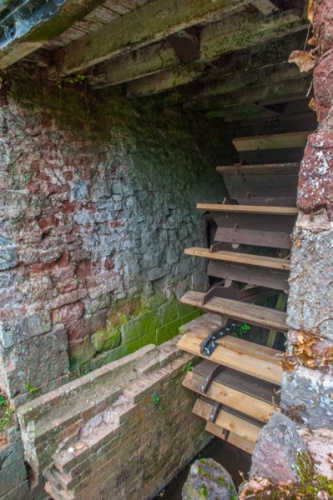
There was a mill recorded at Broadclyst in the Domesday Book of 1086. We can't be sure, but it seems likely that the mill stood on this site. There is not one building here but two; to one side is the mill, dating to the late 18th century and still in full working order.
To the other is the miller's cottage, of the same date, and built of the same red sandstone rubble. The mill is the larger building, standing 3 storeys high, under a slate roof, while the house is two storeys in height.
The mill has an undershot waterwheel on one side, under a weather-boarded lean-to extension over the aptly named Mill Stream. The wheel was installed by the Taylor and Bodley company of Exeter in 1880. The wheel is 4.45 metres by 1.47 metres wide (14.5 feet by 5.8 feet). The wheel retains many of its original timber paddles.

The mill building is relatively complete internally, with its original floors and room divisions. Some of the original mill machinery, however, has been moved to Cotehele Mill in Cornwall, another National Trust property.
There are three millstones, one pair used to grind coarse meal for animal feed, and two pairs of French burr to grind finer flour for human consumption. One pair of stones is set up for milling, the other is lifted up to let visitors see how the stones were dressed for cutting grain.
Though the mill has a long history, it was not always smooth sailing; because the mill depended on water, if there was a period of drought, the wheel could not turn, and no flour could be ground.

Records show that in 1859 the tenant miller, Richard Burton, purchased a steam engine to power the mill wheel, ending its dependence on Mill Stream. An engine of the correct date can be seen at the west end of the mill building; it seems logical to assume that this is the same engine.
Clyston Mill was turned to a variety of uses in the 20th century. After 1915 it pressed apples, and it ground corn into the 1930s. The mill was used to pump water for Broadclyst village until the 1940s, when a water tower was erected to supply local water needs. The old cider press, barrels, and apple crusher are in display in the old pumphouse.

Visitors can see the mill wheel, through a grate in the side of the building, and climb the rickety stairs to the second floor, where the main milling machinery is located.
On the second floor there is a small exhibition area covering the history of the site and the people who worked here. One of those people was Margaret Everleigh, whose family lived in the mill in the 1950s and ran the estate as a farm.
The Everleigh family was one of many local farmers competing to supply milk to local families. Margaret's mother told her that when she decided to marry Margaret's father, her own father was furious, for the bridegroom was a rival farmer and competitor for the milk trade. He was so angry he refused to give his daughter away in the marriage ceremony!
Special milling days provide a chance to see the mill in operation and to buy fresh ground flour. Clyston Mill is also a good location for bird-watching. There are walks along the riverside and through Broadclyst village.

Visiting Clyst Mill
Half the fun is finding the mill in the first place. Signs are a bit confusing - when you can see them, and even the locals I stopped to ask for directions were unsure where to find it. Here's the best way I found; park at the triangular village green, or in the small village parking area just across the road. Go towards the churchyard, keeping the New Inn pub immediately to your right.
As soon as you pass through the gate into the churchyard, turn right, along the stone wall. After a few yards, another signposted path cuts left, across the churchyard, down the slope of the hill to a gate. From there, just follow the obvious footpath over a field, through another gate, to the mill. Its basically just down the slope of the hill from the church, but invisible from the churchyard.
 We've 'tagged' this attraction information to help you find related historic attractions and learn more about major time periods mentioned.
We've 'tagged' this attraction information to help you find related historic attractions and learn more about major time periods mentioned.





